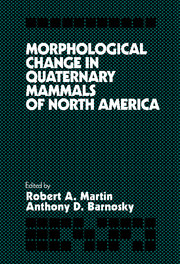Book contents
- Frontmatter
- Contents
- List of Contributors
- Acknowledgments
- 1 Quaternary mammals and evolutionary theory: introductory remarks and historical perspective
- 2 A method for recognizing morphological stasis
- 3 Mosaic evolution at the population level in Microtus pennsylvanicus
- 4 Variogram analysis of paleontological data
- 5 Morphological change in Quaternary mammals: a role for species interactions?
- 6 Rates of evolution in Plio-Pleistocene mammals: six case studies
- 7 Patterns of dental variation and evolution in prairie dogs, genus Cynomys
- 8 Quantitative and qualitative evolution in the giant armadillo Holmesina (Edentata: Pampatheriidae) in Florida
- 9 Evolution of mammoths and moose: the Holarctic perspective
- 10 Evolution of hypsodonty and enamel structure in Plio-Pleistocene rodents
- 11 Patterns of variation and speciation in Quaternary rodents
- 12 Decrease in body size of white-tailed deer (Odocoileus virginianus) during the late Holocene in South Carolina and Georgia
- 13 Short–term fluctuations in small mammals of the late Pleistocene from eastern Washington
- 14 Size change in North American Quaternary jaguars
- 15 Ontogenetic change of Ondatra zibethicus (Arvicolidae, Rodentia) cheek teeth analyzed by digital image processing
- 16 Morphological change in woodrat (Rodentia: Cricetidae) molars
- Index
2 - A method for recognizing morphological stasis
Published online by Cambridge University Press: 15 December 2009
- Frontmatter
- Contents
- List of Contributors
- Acknowledgments
- 1 Quaternary mammals and evolutionary theory: introductory remarks and historical perspective
- 2 A method for recognizing morphological stasis
- 3 Mosaic evolution at the population level in Microtus pennsylvanicus
- 4 Variogram analysis of paleontological data
- 5 Morphological change in Quaternary mammals: a role for species interactions?
- 6 Rates of evolution in Plio-Pleistocene mammals: six case studies
- 7 Patterns of dental variation and evolution in prairie dogs, genus Cynomys
- 8 Quantitative and qualitative evolution in the giant armadillo Holmesina (Edentata: Pampatheriidae) in Florida
- 9 Evolution of mammoths and moose: the Holarctic perspective
- 10 Evolution of hypsodonty and enamel structure in Plio-Pleistocene rodents
- 11 Patterns of variation and speciation in Quaternary rodents
- 12 Decrease in body size of white-tailed deer (Odocoileus virginianus) during the late Holocene in South Carolina and Georgia
- 13 Short–term fluctuations in small mammals of the late Pleistocene from eastern Washington
- 14 Size change in North American Quaternary jaguars
- 15 Ontogenetic change of Ondatra zibethicus (Arvicolidae, Rodentia) cheek teeth analyzed by digital image processing
- 16 Morphological change in woodrat (Rodentia: Cricetidae) molars
- Index
Summary
“Stasis is a real phenomenon” (Eldredge, 1989, p. 72). Although this opinion is rarely stated so explicitly, most discussions of evolutionary rate or change in morphology over time include the assumption that stasis does occur (Futuyma, 1986; Lande, 1986; Bookstein, 1987; Stanley and Yang, 1987; Levinton, 1988; Mayr, 1988; Eldredge, 1989). Stanley and Yang (1987) present a specific example of stasis in fossil and Recent bivalve shape. Barnosky (1987) presents several examples of stasis in small fossil mammals based on an analysis of molar size. Futuyma (1986) recognizes examples of stasis in the extant genus Plethodon. Generally, the questions that need to be addressed are not Does stasis occur? but Why does it occur? and How can we recognize it? This chapter concentrates on the latter question.
“Stasis” has almost as many different definitions as “species” (Eldredge, 1971, 1986, 1989; Stanley, 1982; Lande, 1986; Rose and Bown, 1986; Levinton, 1988; Mayr, 1988). Because “stasis” is used to describe an absence of change in a population of a particular species, the two concepts are frequently used together. Currently, then, the interpretation of stasis may be as unique as the species definition applied to the organism(s) or referred to in discussion. Without direct evidence of reproductive isolation between populations, paleobiologists evoke the morphospecies concept for identifying species. If a morphospecies is a group of individuals that are not significantly different morphologically, then the general criterion for recognizing stasis is identical with the criterion for identifying a particular species and determining species longevity. In this case, character stasis is actually what is recognizable; species stasis is inferred.
Information
- Type
- Chapter
- Information
- Publisher: Cambridge University PressPrint publication year: 1993
Accessibility standard: Unknown
- 1
- Cited by
